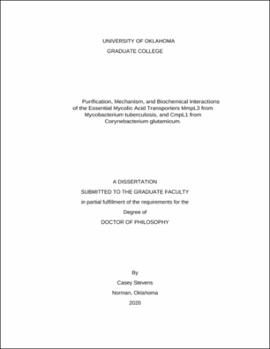| dc.contributor.advisor | Zgurskaya, Helen | |
| dc.contributor.author | Stevens, Casey | |
| dc.date.accessioned | 2020-06-26T15:19:08Z | |
| dc.date.available | 2020-06-26T15:19:08Z | |
| dc.date.issued | 2020-06 | |
| dc.identifier.uri | https://hdl.handle.net/11244/324868 | |
| dc.description.abstract | The Corynebacterium – Mycobacterium – Nocardia family (CMN family) are a subset group of actinomycetes which are characterized as acid-fast, Gram-positive species. Many members of the CMN family are causative agents of human disease with M. tuberculosis, M. leprae, C. diptheria, and N. asteroides historically being exceptionally hard to treat pathogens. One of the reasons the CMN family are resistant to treatment is also the defining trait of the family, which is the presence of an outer membrane with a unique composition of peptidoglycan crosslinked to an arabinogalactan matrix which is further crosslinked to mycolic acids forming an effective outer barrier.
This peptidoglycan – arabinogalactan – mycolic acid barrier forms the inner leaflet of the outer membrane, with loosely associated mycolic acids esterified to disaccharide trehalose sugars forming the outer leaflet of the outer membrane. Both of these structural features together form the ‘myco-membrane’ which is even further complicated by the presence of an outer capsular layer comprised mainly of extended sugar polymers and proteins which are thought to be involved in regulating the hosts’ immune response.
The proper biosynthesis of the myco-membrane is essential for the viability of CMN family pathogens, and the unique physiology of the myco-membrane has made it a primary target for pharmacological therapeutics. In addition to targeting peptidoglycan, the treatment of CMN family pathogens can also include the disruption of arabinogalactan polymerization and the synthesis of fatty acids used in the construction of the more complicated mycolic acids.
Mycolic acids are long-chain saturated fatty acids unique to the CMN family and are found exclusively in the outer myco-membrane. Significant efforts have gone into documenting the biosynthetic pathway of mycolic acid, where it was revealed that the catalytic steps necessary to form these long-chain fatty acids are completed inside the bacterial cell. This raised the question of how these mycolic acids cross the cell membrane in order to be incorporated in the outer membrane. In M. tuberculosis it was shown that mycolic acids could not translocate to the outer leaflet of the inner membrane without the function of the essential membrane transporter MmpL3. The role of MmpL3 as a mycolic acid transporter has since been validated, and MmpL3 has been pursued as a novel pharmacological target. Despite the significance of this discovery, the exact mechanism by which MmpL3 transports mycolic acids across the cell membrane had not yet been described.
The focus of this thesis is on the mechanistic function of the essential mycolic acid membrane transporters CmpL1 from C. glutamicum and MmpL3 from M. tuberculosis, their interactions with inhibitors, and the discovery of novel protein-MmpL3 interactions. To begin our study, we undertook the purification of MmpL3 from M. tuberculosis and CmpL1 from C. glutamicum, and reconstituted them into functional proteoliposomes. Our results from this experiment demonstrate that the mycolic acid transporters facilitate H+ flux across the membrane which is stimulated in the presence of a substrate analog.
As MmpL3 is a significant therapeutic target, several MmpL3 inhibitors have been developed and are in clinical trials. Therefore, we next moved to determine whether these inhibitors directly interact with MmpL3, and if they carry out their function through the inhibition of the observed H+ transport. We utilized a Surface Plasmon Resonance (SPR) assay to successfully determine the direct interaction of a variety of pharmacophores, and we report the kinetic rates of the interactions. Continuing the study of mycolic acid transport inhibition, we pursued a set of novel indole-2-carboxamide (IC) compounds which had both direct interaction and good activity in minimum inhibitory concentration (MIC) assays against M. tuberculosis MmpL3 and C. glutamicum CmpL1. We utilized these IC inhibitors in the proteoliposome assays and report our results that the inhibition of mycolic acid transport is due to the inhibition of H+ flux across the membrane.
MmpL3 carries out the essential function of transporting mycolic acids across the plasma membrane of the bacterial cell. For proper cell wall biogenesis, the timing and incorporation of mycolic acid into the nascent cell wall would need to be coordinated with other biosynthetic machinery. We hypothesized that there would need to be other proteins associated to MmpL3. To test this hypothesis, we identified potential protein interactions via a bacterial two-hybrid screen of the entire Mtb proteome with MmpL3. Potential interacting proteins were independently purified and assayed for direct interaction with MmpL3 using SPR, and we report our results confirming high affinity interactions with several proteins. This significant result provided the first description of the MmpL3 interactome. | en_US |
| dc.language | en_US | en_US |
| dc.rights | Attribution-NonCommercial-NoDerivatives 4.0 International | * |
| dc.rights.uri | https://creativecommons.org/licenses/by-nc-nd/4.0/ | * |
| dc.subject | Biology, Microbiology. | en_US |
| dc.subject | Chemistry, Biochemistry. | en_US |
| dc.subject | Biology, Molecular. | en_US |
| dc.subject | Chemistry, Pharmaceutical. | en_US |
| dc.title | Purification, Mechanism, and Biochemical Interactions of the Essential Mycolic Acid Transporters MmpL3 from Mycobacterium tuberculosis, and CmpL1 from Corynebacterium glutamicum. | en_US |
| dc.contributor.committeeMember | Rybenkov, Valentin | |
| dc.contributor.committeeMember | Bourne, Christina | |
| dc.contributor.committeeMember | Karr, Elizabeth | |
| dc.contributor.committeeMember | Cichewicz, Robert | |
| dc.date.manuscript | 2020-06-25 | |
| dc.thesis.degree | Ph.D. | en_US |
| ou.group | College of Arts and Sciences::Department of Chemistry and Biochemistry | en_US |
| shareok.nativefileaccess | restricted | en_US |

